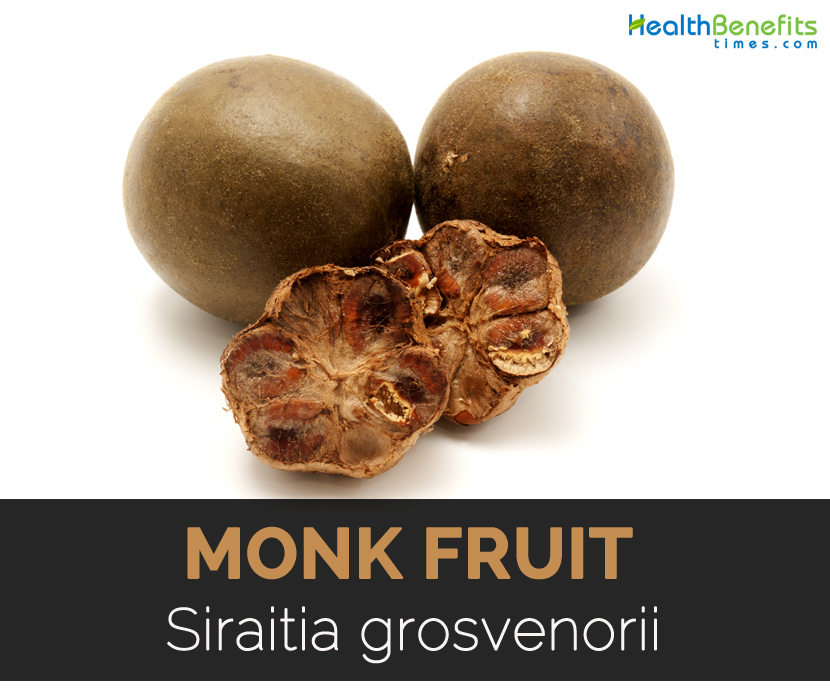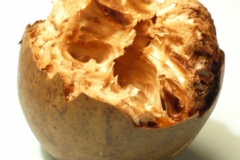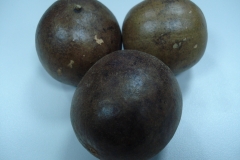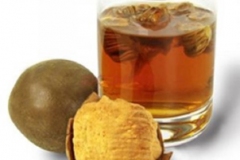History
Monk fruit gets its name from Buddhist Monks who first used it. The monks meditated and lived on misty mountains of Guilin where they encountered a fruit they prized and cultivated for its sweetness as well as healing properties. They used the fruit as healing tonics and developed basic farming techniques to ensure fruit’s survival.
Facts About Monk Fruit
| Monk fruit Quick Facts | |
|---|---|
| Name: | Monk fruit |
| Scientific Name: | Siraitia grosvenorii |
| Origin | Native to southern China – in the south-western Chinese province of Guangxi (mostly in the mountains of Guilin), as well as in Guangdong, Guizhou, Hunan and Jiangxi and Northern Thailand. |
| Colors | Yellow-brownish or green-brownish |
| Shapes | Broadly ellipsoid, ovoid or subglobose, 6–11 cm long |
| Flesh colors | Brown, delicate |
| Name | Monk fruit |
|---|---|
| Scientific Name | Siraitia grosvenorii |
| Native | Native to southern China – in the south-western Chinese province of Guangxi (mostly in the mountains of Guilin), as well as in Guangdong, Guizhou, Hunan and Jiangxi and Northern Thailand. |
| Common/English Name | Arhat Fruit, Fructus Mormodicae, Buddha’s Fruit, Monk’s Fruit, Longevity Fruit, La Han Qua, Lo Han Kuo |
| Name in Other Languages | Chinese: Luó Hàn Guǒ, Ge Si Wei Ruo Guo, Luo Han Kuo, Lor Hon Kor; Japanese: Ra Kan Ka; Vietnamese: La Hán Quả; English: Buddhafruit, Arhatfruit, Monkfruit, Grosvener siraitia, Longevity fruit; Swedish: Sötgurka |
| Plant Growth Habit | Robust, perennial, dioecious climbing herb |
| Plant Size | 2–5 m long |
| Root | Fusiform to sub-globose |
| Leaf | Ovate cordate to hastate, heart-shaped, 8–15 cm long by 3–12 cm wide |
| Fruit shape & size | Broadly ellipsoid, ovoid or subglobose, 6–11 cm long |
| Fruit color | Yellow-brownish or green-brownish |
| Flesh color | Brown, delicate |
| Shell | Thin, light brown, smooth |
| Flavor/aroma | Sweet |
| Seed | Light brownish grey, elongated, 15–18 mm long, 10–12 mm broad |
Plant description
Monk fruit is a robust, perennial, dioecious climbing herb with fusiform to sub-globose roots. The plant grows 2 to 5 meters long and climbs by axillary bifid tendrils. Leaves are ovate cordate to hastate to almost triangular 8–15 cm long by 3–12 cm wide with 2–7 cm long, acute to acuminate apex deeply cordate-emarginate at base. Female inflorescence form in axillary clusters which is solitary, 5-merous with persistent reflexed sepals and yellowish, lanceolate-acuminate thin petals. An ovary is inferior, oblong-ovoid 8–11 mm long by 4–5 mm wide rounded at the base and trilocualr with numerous ovules in six rows. Male inflorescence is racemose and arise singulary from leaf axils. An epicarp is thin but hard with three doubled locules each with two rows of seeds surrounded by brownish grey pulp that dried to light soft material. Seeds are flattened, broadly oval or ovate, light brownish grey and 15–18 mm long, 10–12 mm broad.
Plant
A vine attains length of 3-5 meters climbing over other plant by means of tendrils which twine around anything they touch.
Leaves
Leaves are narrow and heart shaped about 10-20 cm long.
Flowers
Unisexual ones are dioecious; peduncle, pedicel, petals and sepals are pubescent and covered with glandular hairs. Male flowers are axillary and 5-7 are arranged in racemes. Female flowers are solitary in leaf axils. The flowers blooms from June to August and fruiting period is from August to October.
Fruits
Fruit is round, obovate or oblong, 5-7 cm in diameter, smooth, yellow-brownish or green-brownish in color which contains striations from the fruit stem end of furrows with hard but thin skin covered by fine hairs. Skin is dark reddish brown when young and green or pubescent when mature.
Health Benefits of Monk fruit
1. Lowers inflammation
Monk fruit has mogrosides which helps to protect tissues in the body from damage caused by free radicals which is a major source of inflammation. It contradicts inflammatory response caused by sugar consumption. The study shows antioxidant effect to provide protection for insulin secreting cells of pancreas and improves insulin response. It offers anti-inflammatory properties through regulation of blood sugar.
2. Cancer prevention
Cancer is caused due to accumulation of DNA damage caused by free radicals. It optimizes antioxidant systems which lowers DNA damage which occurs and lowers the chances of cancer. Moreover, the same mechanism helps the body to manage existing cancers. Mogrosides found in Monk fruit is studied for its antioxidant properties which show some promising cancer related research demonstrating anti-cancer effects. The study shows that mogroside V helps to inhibit rapid progression of pancreatic cancer cells in mice.
3. Prevents Seasonal Allergy
Cells within bodies are responsible for initiating inflammatory responses when required. The study conducted in mice with monk fruit extract for 4 weeks shows significant reduction in histamine-response to allergens occurred. The same effect was not observed with a single dose. This shows that regular use of monk fruit sweetener provides some allergy relief.
4. Anti-Microbial activity
Monk fruit has anti-microbial properties which maintain proper bacterial balance. The leaves and fruit extracts have shown to inhibit candida, streptococcus and bacteria responsible for gum disease in mouth. The sugar to chemical sweeteners such as sucralose or aspartame does not provide same effect as these sweeteners have bad effect on health of gut microbiome and contributes to unwanted microbial growth.
5. Anti-Fibrotic
Pulmonary fibrosis is a condition in which tissue of lungs becomes scarred and rigid and interferes with ability to breath properly and extract oxygen from the air. Research has observed mogroside IIIE isolated from monk fruit as anti-fibrotic compound with promising results. Study has shown that mogroside IIIE acts as anti-fibrotic by controlling inflammation and helps to regulate cellular matrix deposition.
6. Combat obesity
Eliminating sugar from diet results healthier metabolism and body composition. Study showed the influence of monk fruit, mogrol on fat accumulation and found that it inhibits differentiation of pre-adipocytes into mature adipocytes. It lowers the body’s ability to promote overall fat mass.
7. Protection from Heart Disease
Study shows the effect of monk fruit extract on diabetic mice which revealed that mogrosides have capacity to promote blood sugar response and also control the side effects associated to high cholesterol.
8. Combat Infections
Antibiotics are used for treating bacterial infections. Natural antimicrobial agents are best option to slow ongoing surge of antibiotic resistance. Monk fruit inhibits growth of certain bacteria especially oral bacteria which causes tooth decay and periodontal disease.
Traditional uses
- In traditional Chinese medicine, it is used for respiratory ailments, minor stomach, intestinal troubles, sore throats and aid longevity.
- Fruit is used to provide relief from sunstroke, moisten lungs, stop cough, eliminate phlegm and promote bowel movements.
- It has been used for dry cough, constipation and sore throat for centuries.
- Use in the form of tea for treating inflammation, congestion symptoms, sore throat and coughing.
Applications
- Heat stroke with thirst
Stir fruit into boiled water and drink liquid in place of tea.
- Acute or chronic throat inflammation
Cover half fruit with 3-5 seeds of sterculia with water and simmer then swallow very slowly.
- Chronic cough
Cover one piece of fruit with water and simmer and drink the liquid. Do it twice a day.
- Constipation
Take two pieces of fruit, get the juicy part and the seed, break apart and cover it with water and simmer. Drink it before going to bed.
- Diabetes
Crush the fruit and simmer it into thick juice, add it to prepared fruit or use it as a substitute for sugar.
Culinary uses
- Consume the ripe fruit fresh.
- It is used in form of powder, blocks for beverages, seasoning, in teas, herbal soups, candy, cakes and as traditional medicine.
- In China, it is used in herbal tea.
- Boil Monk fruit with dried longan to make a refreshing herbal drink.
- Use it as a sweetening agent for yogurt, beverages, hard candies, caramel, chewing gum and mouthwash.
- The rind is used to make tea.
- Monk fruit sweeteners are used in salad dressings, smoothies, yogurt, frostings, oatmeal and other cereals.
- In China, Monk fruit is used to make green tea monk fruit jelly.
- Monk fruit pairs well with almonds, dates, ginger, carrots, watercress, cabbage, butternut squash and mushrooms.
Precautions
- It might cause allergic reactions such as hives or rash, difficulty breathing, rapid or weak pulse, dizziness, swollen tongue, stomach pain or vomiting and wheezing.
- Avoid its use and consult the doctor immediately if experienced the above mentioned allergic reactions.
References:
https://en.wikipedia.org/wiki/Siraitia_grosvenorii
https://www.healthline.com/health/food-nutrition/monk-fruit-health-benefits#bottom-line
https://www.specialtyproduce.com/produce/Monk_fruit_8824.php
https://elmaskincare.com/herbs/herbs_monk_fruit.htm
https://drjockers.com/8-health-benefits-monk-fruit/
https://draxe.com/nutrition/monk-fruit/
http://theworldwidevegetables.weebly.com/siraitia-grosvenorii-luo-han-guo.html
https://enacademic.com/dic.nsf/enwiki/1497339
https://www.healthline.com/health/food-nutrition/monk-fruit-health-benefits#health-benefits
https://www.verywellfit.com/monk-fruit-benefits-side-effects-uses-4588601
https://selfhacked.com/blog/monk-fruit/





